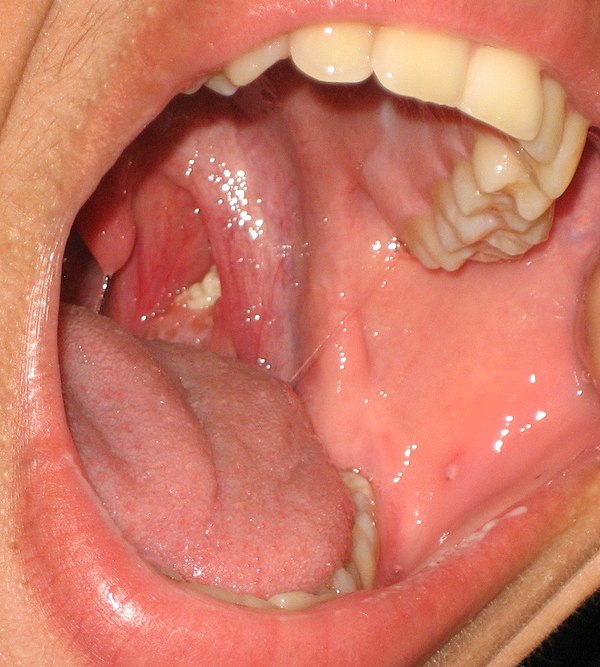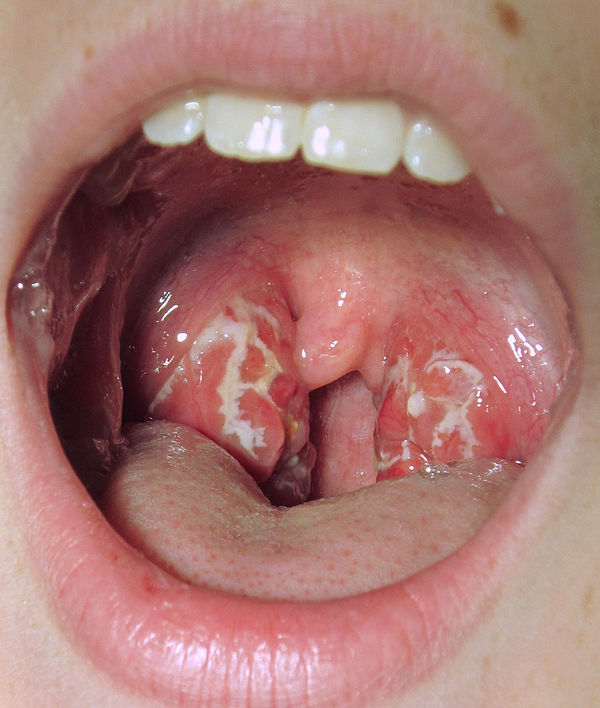This content uses affiliate links. Read our disclaimer for more info.
If you’ve noticed something strange going on with your tonsils, you may be wondering if you’re dealing with tonsil stones or strep throat. They both appear as white spots covering the tonsils, so telling the difference may be a bit tricky if you’re unfamiliar with them.
So, how can you tell if you have tonsil stones or strep throat? Tonsil stones will appear on the tonsils as solid, white or off-white lumps while strep throat will (sometimes) appear as flat, white patches. Tonsil stones can be easily dislodged from the tonsils when nudged with a q-tip or your finger, while spots from strep throat cannot be manually dislodged or wiped away. In addition, the most common symptom of strep throat is throat pain. Tonsil stones are more commonly associated with bad breath rather than pain.
Keep reading for more details on telling the difference between tonsil stones and strep throat:
Appearance
Though the two may sound similar with both being visible white spots; the appearance of your tonsils should be an easy way to tell if you’re dealing with tonsil stones or strep throat.
The white spots caused by strep throat are actually streaks of pus. They will typically look blotchy, patchy and inflamed. In contrast, the white spots caused by tonsil stones will look like hard, rock-like objects.


Unlike the flat, white patches caused by strep throat; tonsil stones can be seen protruding from the crevices that cover the tonsils (known as the tonsil crypts).
It’s possible for tonsil stones to cover both tonsils, but this isn’t usually the case. You may have as little as one or two tonsil stones at a time. It’s also very common to have tonsil stones in only one tonsil rather than both.
When it comes to strep throat, the white patches are commonly seen all over both tonsils. It’s also common for them to appear as “streaks” or “lines” rather than “spots”.
The general rule of thumb for telling the difference between tonsil stones and strep throat by appearance is this: Hard, rock-like objects are most likely tonsil stones. White blotches or streaks are most likely a symptom of strep throat.
Symptoms
The symptoms you’ll experience when dealing with either tonsil stones or strep throat should be a clear way to tell the difference between the two.
The Symptoms of Tonsil Stones: The #1 most common symptom is bad breath. Bad breath is often the biggest complaint among those who have tonsil stones.
Along with bad breath, those with tonsil stones may experience ear & throat pain/itching, throat discomfort, difficulty swallowing, undesirable taste in mouth and/or swollen tonsils. All of these symptoms stem directly from the tonsil stone(s) itself. Any pain, discomfort or swelling experienced will be due to having a hard, possibly sharp or jagged stone lodged in the tonsil and is typically only felt in the tonsil(s) that contains the tonsil stone(s).
It should be noted that it’s possible (and quite common) to have tonsil stones with no apparent symptoms, but bad breath is highly likely.
The Symptoms of Strep Throat: The #1 most common symptoms are sore throat and painful swallowing. The pain associated with strep throat is typically felt both on the tonsils and along the back of the throat.
Strep throat may also be accompanied by a fever, swollen lymph nodes and red throat and/or tonsils.
The general rule of thumb for telling the difference between tonsil stones and strep throat by symptoms is this: If your top symptom is bad breath; you’re most likely dealing with tonsil stones. If you happen to feel pain while having a tonsil stone, the pain will be concentrated in the tonsil(s) that the stone(s) is in. If your top symptoms are sore throat and painful swallowing, it’s most likely strep throat.
The Q-Tip Test
The Q-Tip test is a very easy way to find out what you’re dealing with. Tonsil stones are small, hard clumps that can be easily removed from the tonsil with a Q-tip. In contrast, the white spots caused by strep throat cannot be removed or wiped away by a Q-tip.
How to do the Q-Tip test: take a clean Q-tip and gently nudge near the spot that you suspect may be a tonsil stone or strep throat.
If it’s a tonsil stone: the spot should be able to be dislodged and removed. Alternatively, you can blast out the tonsil stone with a device called a water flosser (I recommend this one. I use to clean my tonsils and prevent tonsil stones from coming back)
If it’s strep throat: you will not be able to dislodge or remove the white spot(s).
The general rule of thumb for telling the difference between tonsil stones and strep throat with the Q-tip test is this: If it can be removed, the white spot is most likely a tonsil stone. If it can’t be removed, the white spot is most likely caused by strep throat.
Conclusion
In the end, tonsil stones and strep throat should be easy to differentiate between.
If you’re dealing with tonsil stones: The spots will appear as hard, rock-like objects. It’s likely that the biggest symptom you’re experiencing is bad breath. The tonsil stones can be easily removed using a Q-tip to dislodge them out of the tonsil.
If you’re dealing with strep throat: The spots you see are likely blotchy and patchy in appearance. It’s likely that the biggest symptom you’re experiencing is a sore throat. The white spots caused by strep throat cannot be removed with a Q-tip
Happen to find out that you have tonsil stones but don’t know how to get rid of them? Don’t worry! My website is filled with information on tonsil stones and how to effectively get rid of them + prevent them from coming back.
Check out this article where I talk about the exact method I used to get rid of my own tonsil stones for good:
How To Get Rid Of Tonsil Stones: The Ultimate Guide
More tips on getting rid of tonsil stones can be found by clicking here.
